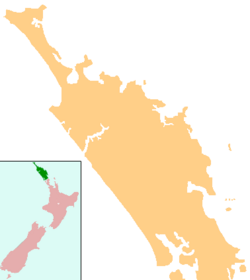Onerahi Causeway facts for kids
Quick facts for kids Onerahi Causeway |
|
|---|---|
|
Location of causeway in Northland
|
|
| Coordinates | 35°43′59″S 174°20′51″E / 35.73306°S 174.34750°E |
| Carries | Riverside Drive |
| Crosses | Whangārei Harbour |
| Locale | Whangārei, New Zealand |
| Maintained by | Whangarei District Council |
| Characteristics | |
| Design | Causeway |
| Total length | 5km |
| History | |
| Opened | 1953 |
| Statistics | |
| Daily traffic | 20,000 |
The Onerahi Causeway is a special road built across water in the Northland Region of New Zealand. It connects the suburb of Onerahi to the city of Whangārei. This important road is about 5 kilometers (3 miles) long.
The causeway crosses over the marshy areas and seabed of the upper Whangārei Harbour. It is a very busy road, with about 20,000 vehicles using Riverside Drive each day. It is one of the most used roads in the region.
Contents
Building the Onerahi Causeway
Why the Causeway Was Needed
The Onerahi Causeway was built between 1950 and 1953. The Whangarei County decided to build it because a better road link was needed. This link would connect Whangārei to areas like Onerahi, Parua Bay, Whangārei Heads, and the Whangarei Airport.
Before the causeway, the old road followed the northern edge of the Whangārei Harbour. It had many small, one-lane bridges over streams that flowed into the harbour. These streams included the Awaroa River and Mackesy Stream. You can still see parts of the old bridge supports today.
How the Causeway Was Built
Building the causeway involved draining parts of the harbour, such as the area near Kissing Point. Workers then built up the road surface. This was done to stop the road from flooding during high tides, known as Spring Tides.
The new road became very straight and flat. It also needed three new bridges to be built along its path. The construction of the causeway also helped to lay down important services. These included pipes for wastewater and fresh water to Onerahi. This work also led to the closing of the old wastewater treatment plant in Onerahi.
The completed causeway made travel to Onerahi much easier. Before this, travel had become harder after the Onerahi Branch Railway closed in 1933.
Adding a Cycleway
In 2016, a cycleway was added along the causeway. This involved making the reclaimed land a bit wider. The cycleway is 6 kilometers (3.7 miles) long. It was built to connect the Waimahanga Walkway and the Hatea Loop. This new path also made it safer for people to walk and cycle from Onerahi to central Whangārei.
Future Plans for the Causeway
Improving Traffic Flow
The causeway, carrying Riverside Drive, is a very important road. It connects the growing communities of Onerahi and Whangārei Heads to Whangārei. Because of this, the road can get very busy during peak travel times.
In 2010, the Whangarei District Council announced plans to make the causeway four lanes wide by 2016. This was meant to help with the traffic.
However, this work was not funded and was later removed from the council's plans. Any future improvements to the causeway might be connected to a planned Onerahi Bypass. This bypass is still being considered for construction.
Related Information
- Onerahi Branch, the railway line that closed before the causeway was built.


